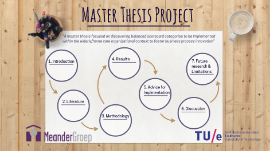Master Thesis Defense
Transcript: Master Thesis Defense Sarah Anna Bradler BA MEM 2015 28/09/2017 Differences in leadership in Austria und Taiwan (R.O.C): A cross-cultural analysis focusing on leadership and discrimination AGENDA 1 Introduction Introduction Literature review Literature review Methodology Methodology Results Results Data Interpetation and Discussion Data Interpetation and Discussion Limitations and suggestions for further research Limitations and suggestions for further research Introduction 2 was raised.. during stay abroad in Taiwan and travelling throughout South East Asia by the challenging political situation worlwide... and intense discussion with locals in Austria and Taiwan Research Motivation Research Motivation Problem Statement Problem Statement Cross-cultural team work in the global environment Cross-cultural team work in the global environment Leadership have to deal with complex tasks have to adapt to a challenging set of competencies to be effective in motivating and leading multinational teams who are able to manage these diverse stressors at a workplace, increase the physical and mental health of the employees on a daily basis and therefore will increase their work performance (Nilsson, Andersson, Ejlertsson, & Troein, 2012, p. 2). Leadership Discrimination omnipresent part of organizational life basically neither positive nor negative but very complex defined as to be a behavior of an individual, organization or a group in which some people are treated differently from others. (Cooper & Cooper, 2016) appears either in a physical or psychological way based on race, ethnicity, culture, religion,…. can lead to severe disorders like post-traumatic stress disorder (PTSD) Discrimination Research Question 1 What are the main differences in Leadership of Teams in Austria compared to Taiwan? Research Question 2 Do employees and leaders perceive discrimination as a present challenge in companies in Austria and Taiwan? Research Question 3 Which steps have to be taken in order to reduce or eliminate discrimination at a workplace in Austria and Taiwan? Research Questions Research Questions Literature review 3 Hofstede`s Cultural Concept Trompenaars Cultural Theory Hall Globe Study Criticism on Theories Culture Culture Hofstede`s Indices Hofstede`s Indices Lewins Leadership Styles Globe Study Leadership Styles Leadership and Cross- Cultural Teamwork Leadership in Taiwan (R.O.C) and Austria Leadership in Taiwan (R.O.C) and Austria Democratic/Participative Leadership Style (Morgan,2013,p.1) Leadership in Austria Leadership in Austria Leadership in Taiwan (R.O.C) Leadership in Taiwan (R.O.C) Discrimination at the workplace Discrimination at the workplace Discrimination is the unfavorable treatment of an individual or a group of individuals based on personal characteristics such as gender, race, color or ethnic or national origin, age, or because of any requirements or conditions that confront the principles of fairness at the workplace. In addition, direct and indirect discrimination as well as harassment and victimization are also included. (edited by the author) Definition Definition created upon the following definitions: United Nations` International Labor Organization (ILO) (‘Convention C111’, 2016); UNESCO (‘Discrimination’, 2017); The Human Rights Commission (Santana, 2017); (Sue et al., 2007); (Marchiondo, Ran, & Cortina, 2015); (Cheung et al., 2016, p. 122); Austrian Equal Treatment Act (GIBG) Austria Austria wealthy modern welfare state about 8 million inhabitants German recognized minorities: Slovenes, Croats, Slovaks, Hungarians, Czechs as well as Roma late 1960s: attracted young workers from Turkey and earlier Yugoslavia early 1990s: Balkan crises with 150000 Bosnian refugees since 1990`s: political rise of FPÖ - openly communicated the idea of a “natural” dominance by so called “true-born” Austrians and “open hostility towards immigrants of Islamic faith” (Publications Office of the European Union, 2016, p. 4) Public Anti-Semitism remains a taboo Age discrimination Homosexuality Disability Gender related discrimination Education and training Income gap Parental leave Discrimination in Austria Discrimination in Austria increasing awareness two separated but correlated legal regimes deal with employment discrimination (foreign workers, gender equality) Women in workforce Gender pay gap Sexual harassment Pregnancy discrimination - “fetal protection policies” Race-based employment discrimination Aborigines Language / Rural dialects Disability Discrimination based on religious belief is seldom Taiwan Taiwan Methodology 4 Research Design Research Design - Secondary Research Secondary Research Anonymous Online Survey Questions: 41 (open questions, Likert-Scale) Language: English, German, Taiwanese based on 42 companies doing business in Austria and Taiwan (list provided by chamber of commerce) Further companies included after intense research 30 respondents Quantitative Analysis Comparisons and Correlations Qualitative

















